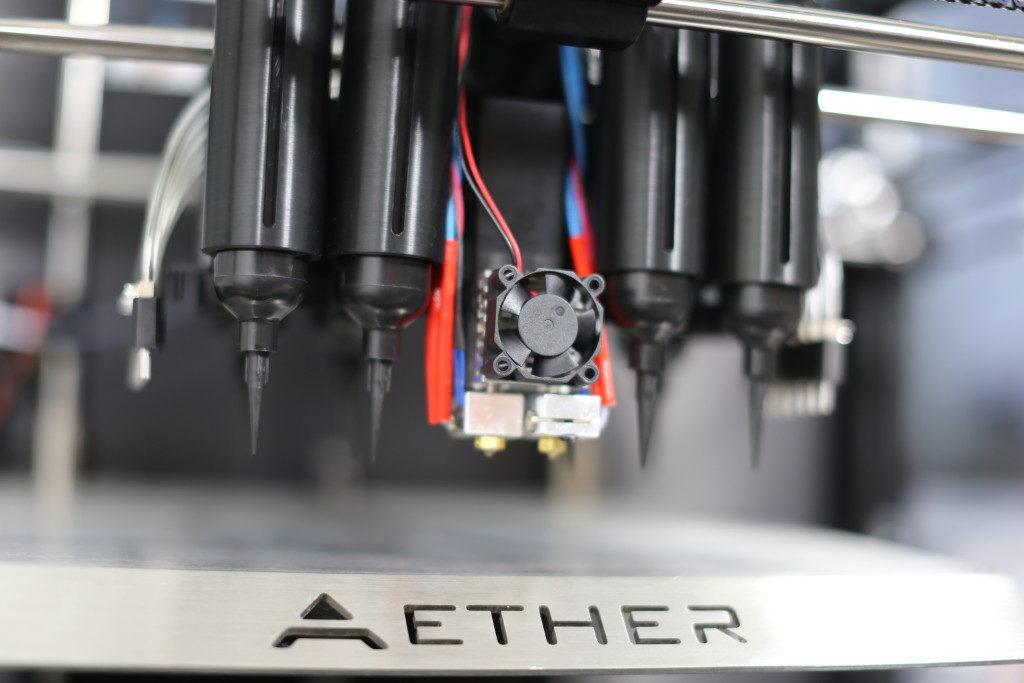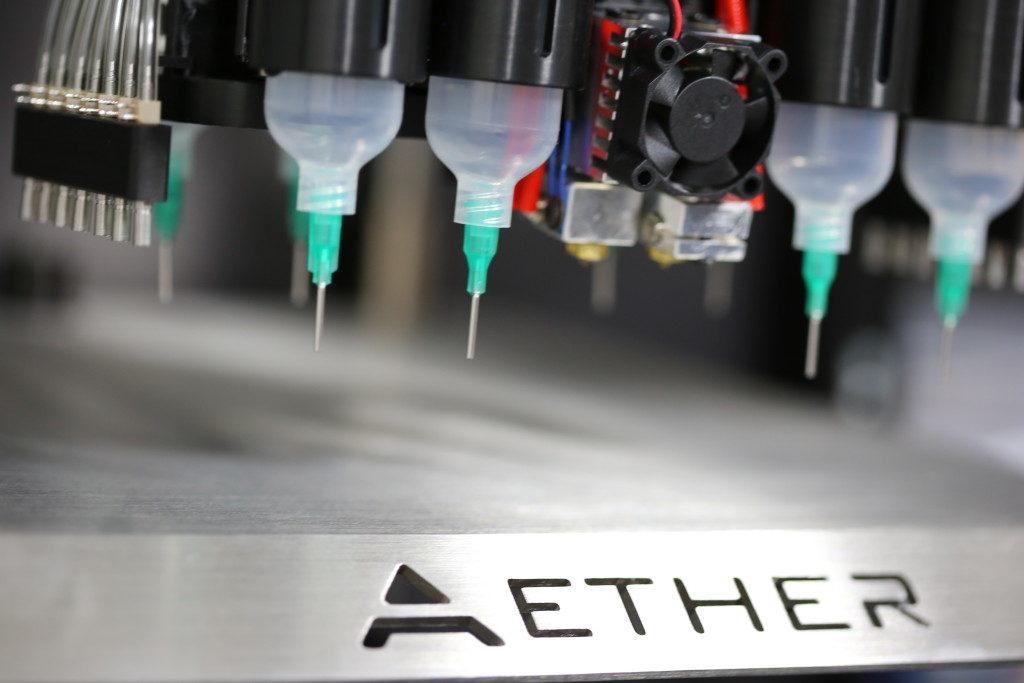Aether 1 Bioprinter Beta Units to Be Involved in Massive Research Project Collaboration, Released Later in Year at $9K
 In a marketplace that grows more fierce by the day, most 3D printing manufacturers have one typical—and important—focus: sales. From Kickstarter campaigns to unveilings at trade shows all over the world, the idea is to get the products into the hands of consumers and begin rocking out those awesome quarterly financial reports as popularity soars.
In a marketplace that grows more fierce by the day, most 3D printing manufacturers have one typical—and important—focus: sales. From Kickstarter campaigns to unveilings at trade shows all over the world, the idea is to get the products into the hands of consumers and begin rocking out those awesome quarterly financial reports as popularity soars.
For Aether, a startup headquartered in San Francisco that we first heard about earlier this year, the focus is on putting their new bioprinters into the hands of researchers and then watching great things happen. Their plan right now is to launch the Aether 1 Bioprinter into a massive collaborative effort around the world, planting their hardware in universities, government institutions, a museum, and a nonprofit organization.
The Aether development team considers their bioprinter to be the ‘most versatile tool ever created,’ and as users begin putting the machines into action, they may soon agree as well. While previously Aether was excited about releasing the bioprinter in beta with the ability to print more than ten materials at a time, they just announced that along with the eight standard syringe extruders and dual hot-end extruders, those who desire more options can also order as many as 14 extra droplet jet extruders—meaning that ultimately, users can be looking forward to using 24 extruders in total.
With the machines to retail at $9,000, Aether promises that their bioprinters, still in the beta phase, will ‘dramatically outperform’ the units on the market today, with some priced closer to $250K. While their original plan was to begin putting beta units in the hands of labs by the end of this summer, they decided to hold off for a bit longer and offer more upgrades and advances to the Aether 1. The beta units should begin shipping out sometime in the fall, and Aether expects the final release to be ready for sale ‘not long after.’
Each entity receiving the units will be conducting one or more research projects in fields such as:
- Biotechnology
- Chemistry
- Mechanical engineering
- Tissue engineering
- Materials science
- Nanotechnology
- Pharmacology
- Implantable device research
- 3D electronics printing
While this is obviously a beta testing period where the company hopes to receive helpful feedback and look into any potential issues with the hardware, their greater hope is that those working with the bioprinters may be able to start working on ‘significant breakthroughs’ in the 3D bioprinting realm, with their findings being published in science journals.
Aether will be offering any assistance needed to the labs as they work on their projects, even if that means creating custom features, which could of course be added to other machines in that future as well. Every facet of this project offers value to those involved—and depending on what the outcome of the projects is—perhaps the world too.
“This is a large-scale bioprinting research collaboration that’s unlike anything ever previously attempted. We’re honored to be working with such an amazing group of researchers,” said CEO Ryan Franks. “Before we even had the chance to officially announce that we were seeking beta users, each of these researchers proactively reached out directly to Aether to find out how they could get an Aether 1. We took that as a sign that this group is extremely eager to innovate with the newest and most powerful bioprinting technology, which makes them the perfect choice to be the very first people to gain access to a completely new kind of bioprinting tool. It’s also an excellent sign that there’s a lot of pent up demand for a product like this that tremendously advances bioprinting technology for an extremely low cost.”

Shown with black plastic syringes with black extruder tips for optimum performance with UV curable materials. Printing stage also available in matte black anodized aluminum for ultimate anti-reflective photocrosslinking performance. [Photo: Aether]
- Cambridge University – Department of Engineering
- Northwestern University – Department of Materials Science and Engineering
- National University of Singapore – Department of Biomedical Engineering/Department of Materials Science and Engineering
- McGill University Health Centre – Montreal General Hospital Orthopaedic Research Laboratory
- Dayton University – Chemical and Materials Department
- University of Minnesota – Bioprinting Facility
- McMaster University – Department of Mechanical Engineering, under supervision of Professor Ravi Selvaganapathy
- Tuft’s University – Computer and Electrical Engineering Department
- University of South Australia – School of Pharmacy and Medical Sciences
- Indiana University Purdue University of Indianapolis – School of Informatics
- University of Washington – UW/Harborview Medical Center Orthopaedics Department
- University of Waterloo – Biomedical Engineering Program/Systems Design Engineering
Printers will also be sent to the following government-backed institutions:
Swiss Center for Electronics and Microtechnology – CSEM is a public-private partnership between the Swiss government and private industry. The center functions as a research and development center specializing in:
- Microtechnology
- Nanotechnology
- Microelectronics
- System engineering
- Photovoltaics
The Aether 1 bioprinter will also be used by the CSEM team to conduct research projects as well as displaying and demonstrating the machine for CSEM’s industrial partners.
Embrapa Genetic Resources and Biotechnology – Embrapa also includes the Laboratory of Nanobiotechnology (LNANO). A state-owned research corporation affiliated with the Brazilian Ministry of Agriculture, Embrapa has nearly 10,000 employees, and according to the Aether team, the brilliant nanobiotechnology researcher Dr. Luciano Silva and his team at LNANO will be collaborating extensively with them to conduct 20 research projects ranging from several months to several years. The projects will largely focus on nanotechnology but also span several widely varying fields.
Aether 1 bioprinters will also be donated to the following:
- National Museum of New Zealand Te Papa Tongarewa – Learning Lab. An Aether 1 beta unit will be donated to this museum and art gallery which receives an average of over 1.5 million visitors per year. The Aether 1 will be used as a method to teach students about 3D printing technology.
- Range of Motion Project – ROMP is a fantastic nonprofit organization working to ensure that people in Latin America can get prosthetics, despite cost issues. With the Aether 1, ROMP will work to improve processes, allow new capabilities, and cut costs for 3D printed prosthetics. Aether may also be featured as an in-kind sponsor when ROMP appears in several upcoming documentary videos by Legendary Pictures, GoPro Films, and the US State Department.
The Aether team hopes to see these collaborations as the beginning of greater accessibility and affordability for labs, as well as a beginning in bringing prices down overall in the bioprinting market. Along with pushing bioprinting progress along further, they also have a strong interest in seeing the need for animal testing to be eliminated. The labs who will currently be using the Aether 1 bioprinters have all agreed not to participate in live animal testing for any of the research during these collaborations.
“Across the ages from the ancient world to the modern one, human potential has always been defined by our tools,” states the Aether team on their website. “The right tools create new possibilities and give us limitless potential. Give an innovative mind a powerful new tool, and there is no limit to what can be accomplished.”
To find out more about this startup and their printing technology, see Aether. Specs for the Aether 1 are as follows:
Fabrication System
- 10+ Extruders on 1 Printhead
- 8 Pneumatic Syringe Extruders with Retraction System
- 2 FFF Hot End Filament Extruders
- Heated Glass Syringe Extruder
- 4,000 Hz Droplet Jetting Extruders
- UV Photo Cross-linking LED
- CNC Milling
- Laser Engraving
- Laser Assisted Bioprinting (LAB)
- Universal Tool Mounts – Use Syringes or Tools of Virtually Any Kind
Display
- 7 inch 480p Touchscreen
Exterior
- Sealed All-Anodized Aluminum and Glass Exterior
- Printer Dimensions:
- 24” x 17 “ x 15” (610 x 432 x 432 mm)
- Max Build Size 12.4” x 9” x 5.2” (315 x 229 x 132 mm)
- Max Build Volume 580.32” (14,732mm)
- Weight 33 pounds
- Built for Desktop Use
Maximum Resolution
- Standard Motor Z axis – 43 nanometers (0.000043mm)
- Standard Motor X/Y axis – 1 micron (0.001mm)
- High Resolution Motor Z axis – 0.4 nanometers (0.0000004mm)
- High Resolution Motor X/Y axis – 10 nanometers (0.00001mm)
- Resolution may be decreased to increase printing speed
Layer Height
- 50 microns (0.05mm)
Software
- Combines Multi Material and Multi Fabrication Method Prints into Single 3D File
- Simplifies Printing Process
Features
- Automatic Air Pressure Calibration – Highly Accurate Machine Vision System
- Automatic Nozzle Cleaning and Unclogging
- Automatic Stage Leveling
- Built for Your Own Materials – No Expensive Proprietary Inks
- Interior Multi Color LED Lighting System
- Interior UV Blacklight LED Lighting System
- Interior Temperature Control
- Heated Printing Surface
- All-Metal Chain and Sprocket Gantry System
- Single or Dual Air Sterility Filtration System
- Wi-Fi
- Mobile App – Monitor and Control Your Print from Anywhere
- Attachable UV Microscope – Machine Vision Options
Discuss this new technology further over in the Aether 1 3D Printer forum at 3DPB.com.
[Source: benzinga]Subscribe to Our Email Newsletter
Stay up-to-date on all the latest news from the 3D printing industry and receive information and offers from third party vendors.
You May Also Like
Profiling a Construction 3D Printing Pioneer: US Army Corps of Engineers’ Megan Kreiger
The world of construction 3D printing is still so new that the true experts can probably be counted on two hands. Among them is Megan Kreiger, Portfolio Manager of Additive...
US Army Corps of Engineers Taps Lincoln Electric & Eaton for Largest 3D Printed US Civil Works Part
The Soo Locks sit on the US-Canadian border, enabling maritime travel between Lake Superior and Lake Huron, from which ships can reach the rest of the Great Lakes. Crafts carrying...
Construction 3D Printing CEO Reflects on Being Female in Construction
Natalie Wadley, CEO of ChangeMaker3D, could hear the words of her daughter sitting next to her resounding in her head. “Mum, MUM, you’ve won!” Wadley had just won the prestigious...
1Print to Commercialize 3D Printed Coastal Resilience Solutions
1Print, a company that specializes in deploying additive construction (AC) for infrastructure projects, has entered an agreement with the University of Miami (UM) to accelerate commercialization of the SEAHIVE shoreline...






























